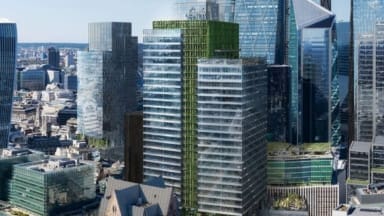
In 2023, the global investment company AXA IM, secured a £480 million construction loan from Cale Street, to fund the development of its new 60,000m2, green next generation office building at 50 Fenchurch Street. The development is planned to start this summer and is expected to be completed in 2028.
The new biodiverse office tower will reportedly be one of the lowest carbon workplace towers in the UK. As part of the firm’s plan to bring greater biodiversity to the Square Mile, the scheme involves incorporating gardens and planted terraces throughout the building, with greenery extending up to the top of the tower. Designed by architect Eric Parry, the building will give the impression of a hanging garden across the facade, pioneering extensive urban greening in the Square Mile.
The 35-storey tower will feature abundant vertical urban greening designed to enhance the workplace environment, biodiversity and air quality. Utilising all electric energy and consuming 50% less energy than a typical office tower, the scheme is targeting sustainable certification (BREEAM Outstanding) and net zero in operation, whilst also adopting the latest innovations to reduce embodied carbon during construction.
Occupying over an acre, 50 Fenchurch sits on the southern edge of the City’s tower cluster, providing panoramic river views over Tower Bridge, the Tower of London and the Southbank. The scheme includes the improvement of two listed buildings; the Grade I listed Tower of All Hallows Staining and the Grade II Lambe’s Chapel Crypt which will become publicly accessible.
In addition to Multiplex, who will build the tower, Eric Parry Architects and Adamson Associates are working alongside Arup who are leading the engineering design, supported by an extensive team of specialists.
Eric Parry, Founder and Principal of Eric Parry Architects said: “The commission to redevelop a site of this scale and significance is special in any city but in the historic heart of the City of London it presents a once-in-a-generation opportunity. The design journey of this urban proposition has been one of the most remarkable alignments between commerce, culture and the public realm that I have experienced. The proposal will unite more than 800 years of the City of London’s history with its future in a development that will dramatically improve the experience of the city for all.”

